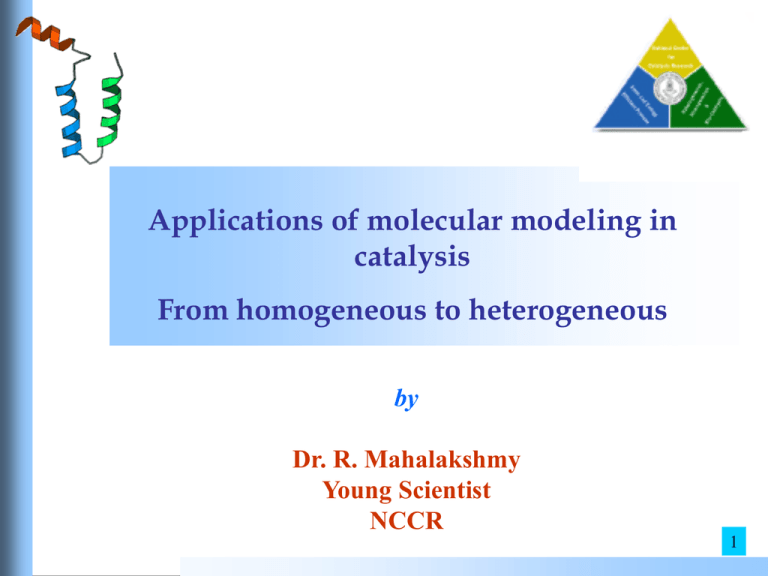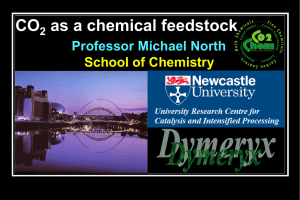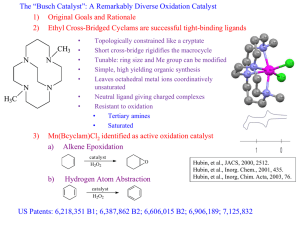MS PowerPoint
advertisement

Applications of molecular modeling in catalysis From homogeneous to heterogeneous by Dr. R. Mahalakshmy Young Scientist NCCR 1 Contents What is molecular modeling? How do we apply molecular modeling to homogeneous system? e.g: Mn-salen (Jacobsen’s catalyst) catalysed epoxidation of olefin How do we apply molecular modeling to heterogeneous system? e.g: Epoxidation of olefin by immobilized Mnsalen catalyst in MCM-41 2 Introduction What is molecular modeling? It is a broadly generic term that defines the use of computers to study chemical systems, with an emphasis on the structure, properties, and activities of molecules. Who is molecular modeler or computational chemist? Those scientist who are specially trained in the technologies, techniques and tools of molecular modeling. Computational tools: • Both software and computer hardware • Computing platform: Ranging from simple desktop computers to the use of very high performance super computers • Support tools: Interface to the codes, data visualizers (programs 3 that create images from the computed data) Methods (i) Molecular mechanics (MM) Properties of the molecule can be calculated by measuring the motion of the atoms and the changing energies of the spring. (ii) ab initio quantum chemical methods Based on the results of calculating the wavefunction, other chemical properties and activities can be determined. (iii) Semi-empirical quantum chemical methods A portion of the calculation comes from experimental data and the rest comes from mathematics. (iv) Density Functional Theory (DFT) Determines molecular properties from calculating the electron density rather than from the wavefunction. *Depending on how broadly one defines molecular modeling or computational chemistry, there are a number of other methods that can be considered. 4 Types of calculations that can be performed on the molecule Single point energies (molecular energies) Molecular orbital calculations, including determination of frontier orbitals Vibrational frequency calculations Reaction mechanisms and reaction path following studies Determination of IR and UV-Vis spectra Transition structures and activation energy diagrams Electron and charge distributions Potential energy surfaces (PES) Thermodynamic calculations 5 Fundamental Uses Chemical structure, or geometry of the molecule Number and type of atoms, bonds, bond lengths, angles, and dihedral angles. Properties of system of molecules Basic characteristics of the molecule, such as its molecular energy, enthalpy, and vibrational frequencies. The activity or reactivity of a molecule Those characteristics that describe how the molecule behaves in the presence of other molecules, such as its nucleophilicity, electrophilicity, and electrostatic potentials. 6 Other uses To model a molecular system prior to synthesizing that molecule in the laboratory. Understanding a problem more completely. Some properties of molecule can be obtained computationally more easily than by experimental means. e.g. Molecular bonding Anyone can do calculations nowadays. Anyone can also operate a scalpel. That doesn’t mean all our medical problems are solved. -Karl Irikura 7 Jacobsen epoxidation Jacobsen Epoxidation: Enantioselective synthesis of epoxides from isolated alkene. Jacobsen's catalyst • The commercially available '1994 reagent of the year. • Converts achiral olefins to chiral epoxides with enantiomeric excesses regularly better than 90% and sometimes exceeding 98%. • To date, the origin of this dramatic selectivity has not been explained. 8 Catalytic cycle involved in the epoxidation Step1:An oxidant transfers atomic oxygen to the MnIII catalyst (the oxygen presumably coordinates to the metal in a site normal to the salen plane) Step2:The activated oxygen is then delivered to the alkene. 9 Three possible modes of oxygen delivery Mechanisms of oxygen transfer from the catalyst to the olefin Step A: Attack of an oxygen radical intermediate on the double bond Step B: Concerted oxygen delivery & Step C: Formation of a metallaoxetane intermediate 10 Investigation of the stereoselectivity of the Mn(III)salen catalysed epoxidation reaction mechanism by DFT Highly enantioselective!!! What is its origin??? (1) How can the relatively flat catalyst give such impressive selectivity? (2) What is the trajectory of approach of alkenes (top, side, or bottom on 1) to the MnO intermediate? (3) What is the timing of bond formation between the alkene and transferred oxygen? *The above issues can be explored in more details by computing the geometries of the manganese-Oxo intermediate as a prelude to 11 transition state searches. Computational details Program: Gaussian-94 Theory:DFT Functional:B3LYP Basis set: (C, H, Cl, N,O) Split valence double (DZ) basis set: 3-21G Double plus polarisation basis set : 6-31G* DZ and TZ valence basis set for Mn Org. Lett., Vol. 1, No. 3, 1999 12 Model systems employed in calculation N N N O 1 - Mn(III) N N O O 2-Mn(V) N Mn O N Mn O O N Mn Mn O O Cl 3 -Mn(III) O O Cl 4-Mn(V) 13 13 Spin multiplicity 3d7 Mn(0) Oxidation state range: II to VII Mn(III) eg eg eg t2g t2g t2g Low spin singlet (S=0) Intermediate spin Triplet (S=1) High spin Quintet (S=2) Mn(III) d2(Oh) Mn(V) Triplet (S=1 d4 (Oh) d4 (Oh) eg eg eg t2g t2g t2g Singlet (S=1) Quintet (S=2) 14 Quintet and triplet state geometries of the Manganese(III) model systems 1 H.S (q) 1 L.S (t) 3 H.S (q) 3 H.S (t) 15 Manganese(V) model compounds calculated by the manganese triple- basis/Becke3LYP/6-31G* 2 (s) 0 kcal/mol 2(t) 3.5 kcal/mol 2 (q) 11.2 kcal/mol 4 (s) 10.2 kcal/mol 4 (t) 0 kcal/mol 4 (q) 2.0 kcal/mol 16 Comparison of X-ray data to calculated values for model systems X-ray B3LYP/ 3-21G B3LYP/ 6-31G* [Mn(dz)] B3LYP/ 6-31G* [Mn(tz)] Mn-N N-Mn-N Mn-O O-Mn-O Mn-Cl 2.001/ 1.986 1.945/ 1.929 1.958/ 1.952 83.8 1.871/ 1.853 1.873/ 1.867 1.900/ 1.900 90.3 2.391 90.6 2.352 92.1 2.239 1.967/ 1.961 82.1 1.905/1.9 04 92.1 2.231 82.7 82.6 17 Becke3LYP/3-21G relative energies (kcal/mol) for model systems 1-4 1 Mn(III) s t 3 Mn(III)Cl q s t 2 Mn(V)O q s t 0.8 0.0 2.1 E 48.4 27.6 0.0 53.1 30.5 0.0 S2 2.7 6.0 2.1 6.1 4 Mn(V)O/Cl q s t q 16.3 11.7 0.0 4.0 6.0 2.9 6.1 The <S2> values measure whether the spin state is pure singlet, triplet or quintet (S2 = 0, 2, 6, resp) 18 Becke3LYP/6-31G* (CHClNO)/DZ (Mn) relative energies (kcal/mol) for model systems 1-4 1 Mn(III) s t 3 Mn(III)Cl q s t 2 Mn(V)O 4 Mn(V)O/Cl q s t q s t q 0.0 4.3 10.0 8.2 0.0 1.2 2.1 6.1 2.9 6.1 E 43.6 22.6 0.0 35.4 26.8 0.0 S2 2.6 6.1 2.0 6.1 19 Becke3LYP/6-31G* (CHClNO)/TZ (Mn) Relative energies (kcal/mol) for model systems 1-4 1 Mn(III) E S2 3 Mn(III)Cl s t q 45.7 27.1 0.0 2.6 6.1 S t 2 Mn(V)O q s t 40.2 19.5 0.0 0.0 3.5 2.1 6.1 2.1 4 Mn(V)O/Cl q s t q 11.2 10.2 0.0 2.0 6.1 2.9 6.1 •The Mn(III) catalysts are predicted to be high spin (i.e Quintet) The ligand field does not split the degeneracy of the d orbitals significantly - No spin pairing •Mn(V)Oxo is predicted to have nearly degenerate singlet and triplet states. 20 Conclusion •A low – spin ( s or t) complex is favoured with weak coordination or absence of a 6th ligand • A high spin (t or q) state occurs upon association of a stronger ligand. • High spin oxo intermediate could lead directly to high spin product in a concerted fashion with conservation of spin. • Low spin species would have to undergo a change of spin multiplicity during reaction which could give stepwise processes. *Nature of the ligand will influence spin multiplicities and potentially the relative rates of stereo specific concerted and stepwise nonconcerted processes. 21 Investigation of the origin of enantioselectivity in the epoxidation of alkenes catalysed by anchored oxo Mn(V)-salen into MCM-41 channels DFT and QM/MM approach Journal of molecular catalysis A: Chemical 271(2007) 98-104 22 Objective Based on DFT and QM/MM calculations, To rationalise the effect of immobilization and show how that correlates with the linker and substrate choices. To evaluate the enantioselectivity of the catalyst with respect to the energy surfaces along the epoxidation reaction pathway. 23 Model systems employed in calculation N N N Mn L N Mn O O O O O L I II The full (I) and truncated (II) models of the Mn-salen complex L(axial linker) = Cl-, Phenoxyl 24 Model systems employed in calculation (a) Visualized Mn-salen complexes anchored inside a MCM-41 channel using phenoxyl group as the immobilizing linker (b) The model for the immobilized Mn-salen complexes using phenoxyl axial linkage. 25 Relative energies of spin states for oxo-Mn-salen II complex vs. axial linkage (Calculated by Mn(tz) basis using B3LYP/6-31G* functional) Method Spin state Mn-salen-Cl (truncated) Mn-salenphenoxyl (truncated) B3LYP B3LYP B3LYP Singlet Triplet Quintet 10 0 2 50 0 10 •The triplet state is found to be the ground state for both Cl- and phenoxyl linkers. • Epoxidation reaction for both homogeneous catalyst (i.e., Cl- is the axial ligand) and heterogeneous catalysts (i.e., phenoxyl group is the axial ligand) occurs on a triplet surface. 26 Effect of axial linkage on the geometry of oxo-Mn-salen II for the triplet spin sate using B3LYP method: distances in A° , angles in degrees Bond/angle Mn-salen-Cl truncated) Mn-salen-phenoxyl truncated) Mn= O(oxo) 1.82 2.11 Mn=O(phenoxyl) 2.34 1.85 Ligand plane…Mn 0.184 0.555 Mn–O(oxo)–L 56. 940 124.930 27 DFT-calculated structures for the truncated Oxo-Mnsalen II with Cl− Optimised structure HOMO LUMO 28 Optimized geometry of TS1 and TS2 corresponding to the attack of TBMS for homogeneous Mn-salen catalyst 29 General mechanism scheme for asymmetric epoxidation of olefins using Mn-salen complexes, L = axial linker 30 Reaction profiles for the oxygen transfer reaction on the triplet surface for homogeneous Mn-salen catalyst 1. It is the mixture of CBMS and the catalyst in gas phase without any interaction in between. 2.Olefin enters the coordination sphere of complex from the Mn=O center. Activation energy for TS1=22 kJmol 3. Formation of radical intermediate.(90 kJ/mol more stable than 2) Activation energy for TS2=35 kJ/mol Trans--methyl styrene (TBMS) 4.Formation of Epoxide 31 Cis--methyl styrene (CBMS) complex. Results of DFT calculation • The attack of TBMS is overall about 7 kJ/mol less in favour compared to that in CBMS. •The epoxide complex formed by TBMS lies 2.5 kJ/mol below the epoxide complex formed by CBMS. •These findings are in agreement with a general assumption in homogeneous Mn-salen catalyst that TBMS is a less suitable substrate than CBMS. •The more stable t rans-epoxide complex 4 is in qualitative agreement with the experimental observation that epoxidation of CBMS leads to a thermodynamically more stable trans-epoxide 32 DFT-calculated structures for the truncated oxo-Mn(II)salen with phenoxyl, located trans- to the oxo group HOMO LUMO 33 Optimised geometry of the transition states TS1 and TS2 corresponding to the attack of TBMS at the Mn=O center of heterogeneous Mn-salen catalyst 34 Energy profile for the epoxidation reaction of CBMS and TBMS catalyzed by immobilized Mn-salen complex. TBMS CBMS 35 Result DFT calculation for the attack of CBMS •The activation barrier for the formation of adsorbed CBMS radical is overall 8 kJ/mol less than that for the homogeneous salen catalyst. (Homogeneous catalyst =22 kJ/mol; heterogeneous catalyst=14 kJ/mol) •The activation energy for epoxide complex formation is about 5 kJ/mol lowered for the immobilized Mn-salen complex than that for the homogeneous salen catalyst. (Homogeneous catalyst=35 kJ/mol; heterogeneous catalyst=30 kJ/mol) •On the triplet energy surface, the calculations suggest that epoxide formation is clearly more preferred by the immobilized catalyst compared to the homogeneous catalyst. •These observations provide an explanation for the effectiveness and importance of additional ligand as the immobilizing linker. 36 DFT calculation for the attack of TBMS •In contrast to the homogeneous epoxidation reaction, a trans olefin can be a suitable substrate for epoxidation by immobilized Mn-salen catalysts. •Epoxide complex 4 formed of CBMS is slightly (3 kJ/mol) more stable than its trans-epoxide counterpart, despite of the fact that there is a lower barrier (5 kJ/mol) towards epoxide formation starting from TBMS radical adsorbed on Mn=O center. •The energy profile strongly depends on electron donor/acceptor properties of the axial linker. 37 Modelling of MCM-41 silica channel •MCM-41 silica channel was modelled based on a straight, three-dimensional channel. Pore length= 3.4 nm •The structure was represented by the pseudo cell, Si6O12, consists of hexagon arrangements of Si–O–Si units. •Oxygen atoms saturate all silicon atoms at the pore surface. •Oxygen atoms with fewer than two silicon atoms attached to them (at the inlet, outlet and outer surface) were then saturated by hydrogen atoms. 38 Modelling of MCM-41 silica channel •This model places the silicon and oxygen atoms in a simple geometrical arrangement and does not reproduce the real amorphous structure of MCM-41. •In this MCM-41 model, all hydroxyl groups were located at the outer surface. •The pore length is 3.4 nm and the pore diameter is 2.3 nm. • Immobilization was performed by attaching the Si atom of the linker to oxygen atoms connected to two Si atoms on the wall (SiLinker–O–SiMCM). 39 Model used for ONIUM based QM/MM calculation • A two-layer ONIOM protocol was used to couple the QM and MM parts in the full Mn-salen-L (L = pheoxyl) calculations as well as for the immobilized Mn-salen catalyst into MCM-41 channel. •The high-level model system includes Mn, N, O, carbon atoms at the bridge and the full substrate and linker atoms. •The low level calculation includes the rest of salen ligand and the atoms of MCM-41 channel. 40 Reaction profiles for the epoxidation of CBMS on the triplet surface for Mn-salen immobilized into MCM-41 channel using a phenoxyl linker •Energy barrier are lower because of the confinement effect inside MCM-41 channel. • The more restricted space inside the mesopore in combination with the effect of immobilizing linker hinders the free-movement of the attached olefin. • Besides, a full-salen ligand with substituents at 5, 5and 3, 3-positions exhibits stronger steric influences compared to that for the model complex II. 41 Conclusions • Catalyst Homogeneous Heterogeneous Suitable substrate cis-olefin Trans-olefin Main product trans-epoxide cis-epoxide •Comparison of the optimized structure of the intermediate oxo-Mn-salen with the chloride and phenoxyl linker at the trans-position leads to the following suggestions: Any coordination in the trans-position causes the Mn atom to move into the plane of the ligand. The movement of the Mn atom can improve the enantioselectivity in view of the shielding of the oxygen by the equatorial ligands. The Mn=O bond becomes lengthened –facilitates oxygen transfer to the olefin. •A trans-substrate has a higher level of asymmetric induction to the immobilized Mn-salen complex than that to a homogeneous catalyst, but the reaction path is more in favor of the cis-substrate. •The MCM-41 channel reduces the energy barriers and enhances the enantioselectivity by influencing geometrical distortions of the Mn-salen complex. 42 43 Questions? 44







